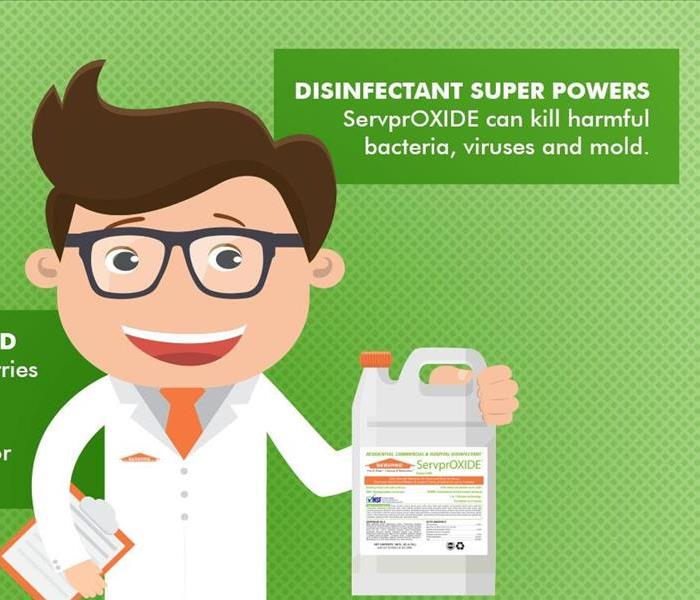Cleaning & Disinfecting for COVID-19
4/1/2020 (Permalink)
 The product that is used for the cleaning and disinfecting. We want to help do our part by stopping the spread of the virus!
The product that is used for the cleaning and disinfecting. We want to help do our part by stopping the spread of the virus!
Hello,
We have been out servicing 911 call centers, trucks, distribution warehouses and distribution offices that are keeping our stores stocked with supplies and know that our Police and Fire Departments also need to be out to protect our communities but also need to stay free from a spread of the SARS-CoV-2” COVID-19 .
We here at SERVPRO wanted to let you all know that we are currently are open to help combat the spread of the virus. SERVPRO, with direction from the CDC have put together protocol to deal with “SARS-CoV-2” COVID-19 pro-actively (pre-positive test) and reactively (post-positive test).
These general guidelines are broad in scope and are not-specific protocols. Any protocols from federal, state, local agencies, or an industrial hygienist would supersede these guidelines. A CAT system has been designed for the different calls as it relates to “SARS-CoV-2” COVID-19.
CAT1: Proactive cleaning only CAT2: Person under investigation (PUI) or possible exposure CAT3: Confirmed, positive case
The protocol for CAT 1 is attached along with the SDS sheets, Chemical information, approval forms and rates for the services. We know that it is ever changing at a rapid rate and is very volatile. If you are in need of any services please reach out to us and we will do our best to help answer any questions or perform any work.
CAT 2 and CAT 3 – Protocol:
The Centers for Disease Control and Prevention (CDC) is closely monitoring an outbreak of respiratory illness caused by a novel (new) coronavirus (named “SARS-CoV-2”) that was first detected in Wuhan City, Hubei Province, China, and spread to dozens of countries throughout the world. This is an emerging, rapidly evolving situation and the CDC will provide updated information as it becomes available, in-addition to updated guidance.
https://www.cdc.gov/coronavirus/2019-ncov/community/organizations/cleaning-disinfection.html
Cleaning and Disinfection After Persons Suspected/Confirmed to Have COVID-19 Have Been in the Facility
Timing and location of cleaning and disinfection of surfaces
- At a school, daycare center, office, or other facility that does not house people overnight:
- It is recommended to close off areas used by the ill persons and wait as long as practical before beginning cleaning and disinfection to minimize potential for exposure to respiratory droplets. Open outside doors and windows to increase air circulation in the area. If possible, wait up to 24 hours before beginning cleaning and disinfection.
- Cleaning staff should clean and disinfect all areas (e.g., offices, bathrooms, and common areas) used by the ill persons, focusing especially on frequently touched surfaces.
- At a facility that does house people overnight:
- Follow Interim Guidance for US Institutions of Higher Education on working with state and local health officials to isolate ill persons and provide temporary housing as needed.
- It is recommended to close off areas used by the ill persons and wait as long as practical before beginning cleaning and disinfection to minimize potential for exposure to respiratory droplets. Open outside doors and windows to increase air circulation in the area. If possible, wait up to 24 hours before beginning cleaning and disinfection.
- In areas where ill persons are being housed in isolation, follow Interim Guidance for Environmental Cleaning and Disinfection for U.S. Households with Suspected or Confirmed Coronavirus Disease 2019. This includes focusing on cleaning and disinfecting common areas where staff/others providing services may come into contact with ill persons, but reducing cleaning and disinfection of bedrooms/bathrooms used by ill persons to as needed.
- In areas where ill persons have visited or used, continue routine cleaning and disinfection as in this guidance.
How to Clean and Disinfect
Surfaces
- If surfaces are dirty, they should be cleaned using a detergent or soap and water prior to disinfection.
- For disinfection, diluted household bleach solutions, alcohol solutions with at least 70% alcohol, and most common EPA-registered household disinfectants should be effective.
- Diluted household bleach solutions can be used if appropriate for the surface. Follow manufacturer’s instructions for application and proper ventilation. Check to ensure the product is not past its expiration date. Never mix household bleach with ammonia or any other cleanser. Unexpired household bleach will be effective against coronaviruses when properly diluted.
- Prepare a bleach solution by mixing:
- 5 tablespoons (1/3rd cup) bleach per gallon of water or
- 4 teaspoons bleach per quart of water
- Products with EPA-approved emerging viral pathogens claims are expected to be effective against COVID-19 based on data for harder to kill viruses. Follow the manufacturer’s instructions for all cleaning and disinfection products (e.g., concentration, application method and contact time, etc.).
- For soft (porous) surfaces such as carpeted floor, rugs, and drapes, remove visible contamination if present and clean with appropriate cleaners indicated for use on these surfaces. After cleaning:
- If the items can be laundered, launder items in accordance with the manufacturer’s instructions using the warmest appropriate water setting for the items and then dry items completely.
- Otherwise, use products with the EPA-approved emerging viral pathogens claims (examples at this link) that are suitable for porous surfaces
Thank you for your time and stay safe.





 24/7 Emergency Service
24/7 Emergency Service